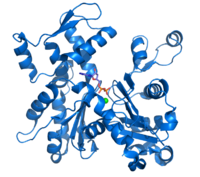
Further delineation of putative ACTB loss‐of‐function variants: A 4‐patient series
Sign Up to like & getrecommendations! Published in 2020 at "Human Mutation"
DOI: 10.1002/humu.23970
Abstract: ACTB encodes β‐cytoplasmic actin, an essential component of the cytoskeleton. Based on chromosome 7p22.1 deletions that include the ACTB locus and on rare truncating ACTB variants, a phenotype resulting from ACTB haploinsufficiency was recently proposed.… read more here.
Keywords: loss function; function variants; actb loss; putative actb ... See more keywords

An assessment of the role of vinculin loss of function variants in inherited cardiomyopathy
Sign Up to like & getrecommendations! Published in 2020 at "Human Mutation"
DOI: 10.1002/humu.24061
Abstract: The ACMG/AMP variant classification framework was intended for highly penetrant Mendelian conditions. While it is appreciated that clinically relevant variants exhibit a wide spectrum of penetrance, accurately assessing and expressing the pathogenicity of variants with… read more here.
Keywords: vinculin; penetrance; loss function; function variants ... See more keywords

LRRK2 Loss‐of‐Function Variants: When Less Is More
Sign Up to like & getrecommendations! Published in 2020 at "Movement Disorders"
DOI: 10.1002/mds.28291
Abstract: Gain-of-function variants in leucine-rich repeat kinase 2 (LRRK2) are the most common monogenic cause of Parkinson’s disease (PD), albeit with incomplete penetrance, indicating that reduction of LRRK2 kinase activity is a reasonable therapeutic strategy for… read more here.
Keywords: lof variants; lrrk2 lof; function variants; lrrk2 ... See more keywords

Genetic and clinical characteristics of 24 mainland Chinese patients with CTNNB1 loss‐of‐function variants
Sign Up to like & getrecommendations! Published in 2022 at "Molecular Genetics & Genomic Medicine"
DOI: 10.1002/mgg3.2067
Abstract: Neurodevelopmental disorder with spastic diplegia and visual defects (NEDSDV) is a rare autosomal dominant syndrome, which is caused by the heterozygous germline loss‐of‐function variants in CTNNB1. read more here.
Keywords: function variants; genetic clinical; clinical characteristics; loss function ... See more keywords

Novel loss of function variants in FRAS1 AND FREM2 underlie renal agenesis in consanguineous families
Sign Up to like & getrecommendations! Published in 2020 at "Journal of Nephrology"
DOI: 10.1007/s40620-020-00795-0
Abstract: Congenital anomalies of the kidney and urinary tract (CAKUT) are a group of abnormalities that affect structure of the kidneys or other structures of the urinary tract. The majority of CAKUT are asymptomatic and are… read more here.
Keywords: agenesis; novel loss; renal agenesis; loss function ... See more keywords

Using ALoFT to determine the impact of putative loss-of-function variants in protein-coding genes
Sign Up to like & getrecommendations! Published in 2017 at "Nature Communications"
DOI: 10.1038/s41467-017-00443-5
Abstract: Variants predicted to result in the loss of function of human genes have attracted interest because of their clinical impact and surprising prevalence in healthy individuals. Here, we present ALoFT (annotation of loss-of-function transcripts), a… read more here.
Keywords: putative loss; disease; loss function; function variants ... See more keywords

Loss-of-function variants in ADCY3 increase risk of obesity and type 2 diabetes
Sign Up to like & getrecommendations! Published in 2017 at "Nature genetics"
DOI: 10.1038/s41588-017-0022-7
Abstract: We have identified a variant in ADCY3 (encoding adenylate cyclase 3) associated with markedly increased risk of obesity and type 2 diabetes in the Greenlandic population. The variant disrupts a splice acceptor site, and carriers… read more here.
Keywords: obesity type; risk obesity; loss function; type diabetes ... See more keywords

A recognizable type of syndromic short stature with arthrogryposis caused by bi‐allelic SEMA3A loss‐of‐function variants
Sign Up to like & getrecommendations! Published in 2017 at "Clinical Genetics"
DOI: 10.1111/cge.12967
Abstract: The semaphorins constitute a large family of secreted and membrane‐associated proteins that regulate many developmental processes, including neural circuit assembly, bone formation and angiogenesis. Recently, bi‐allelic loss‐of‐function variants in SEMA3A (semaphorin 3A) were identified in… read more here.
Keywords: stature; short stature; type syndromic; loss function ... See more keywords

Abstract 13583: Secondary Findings of Loss-of-function Variants in FLNC Are Associated With Arrhythmogenic Cardiomyopathy Phenotypes in a General Clinical Population
Sign Up to like & getrecommendations! Published in 2020 at "Circulation"
DOI: 10.1161/circ.142.suppl_3.13583
Abstract: Introduction: The FLNC gene, encoding the Filamin C sarcomere protein, has gained recent attention as a potential cause of severe cardiomyopathy and arrhythmia phenotypes through genetic testing of... read more here.
Keywords: 13583 secondary; findings loss; abstract 13583; function variants ... See more keywords

Enrichment of Motilin Receptor Loss-of-Function Variants in Gastroparesis
Sign Up to like & getrecommendations! Published in 2022 at "Clinical and Translational Gastroenterology"
DOI: 10.14309/ctg.0000000000000474
Abstract: Introduction: Gastroparesis is a serious medical condition characterized by delayed gastric emptying and symptoms of nausea, vomiting, bloating, fullness after meals, and abdominal pain. Methods: To ascertain the genetic risk factors for gastroparesis, we conducted… read more here.
Keywords: loss function; function variants; gastroparesis; motilin receptor ... See more keywords

In Silico Designed Gain-of-Function Variants of Complement C2 Support Cytocidal Activity of Anticancer Monoclonal Antibodies
Sign Up to like & getrecommendations! Published in 2022 at "Cancers"
DOI: 10.3390/cancers14051270
Abstract: Simple Summary The complement system can be exploited by anticancer antibody-based therapeutics. Activation of the classical complement pathway by the heavy chain of antibodies eventually leads to the lysis of target cells. However, overexpression of… read more here.
Keywords: function variants; complement; activity; gain function ... See more keywords